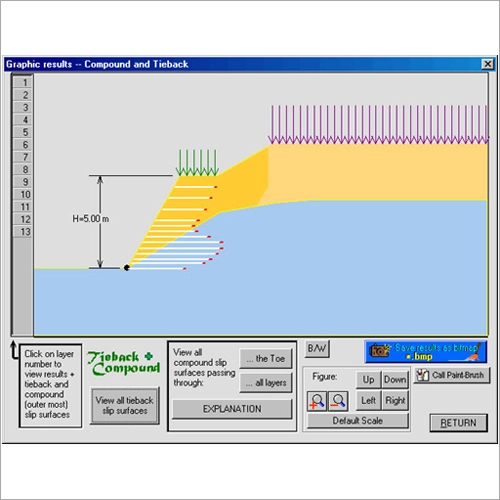ReSlope Software

ReSlope Software
- Printout: The user can print a built-in report in one of the following languages: English, Dutch, Finnish, French, German, Italian, Polish, Portuguese, Russian, Spanish, or Swedish.
- Slope geometry is limited to simple shape; backslope can be specified; three different uniform surcharges over the crest can be input. Slope height is limited to 30 m. Taller slopes can be analyzed using a similitude approach.
- Sloping toe can be specified. Its effects are realized in deepseated stability analysis using Bishops; however, ReSlope does not consider the foundation effects on internal stability.
- An approximated methodology for reinforced tiered slopes is presented. However, this option is not automatic or straightforward; it requires a considerable judgment by the user.
- Input data includes three types of soils: reinforced soil, retained soil and foundation soil. Cohesion strength component can be specified for each soil, however, for design it is highly recommended to use zero cohesion, especially for the reinforced and retained soils.
- Porewater pressure can be approximated either through a simple phreatic surface or by the porewater coefficient ru.
- Pseudostatic seismicity is considered using horizontal and vertical coefficients.
- Soil-geosynthetic interaction is considered through the input of the Interaction Coefficient (Ci) and the Direct Sliding Coefficient (Cds).
- Geosynthetic lengths can be generated as uniform, linearly varying with height, or minimum required values at each elevation. Although the minimum required length option is not practical for construction, it is valuable for the designer in assessing the extent of conservatism associated with the actual specified layout.
- The user specifies reduction factors for creep, degradation, and installation damage.
- The user specifies different overall factors of safety for the geosynthetic strength, for the shear strength of soils, for pullout resistance and for direct sliding resistance. Each target factor of safety is input individually (i.e., not necessarily the same Fs for soil and geosynthetics), thus making ReSlope compatible with design philosophies of MSE walls.
- Coverage Ratio, Rc, can be input (allowable values between 0.05 and 1.0; recommended value for design is 1.0).
- The user can specify the inclination of reinforcement force at the slip surface, inputting any value between horizontal and tangential (horizontal is recommended for geosynthetics).
- The user can specify fixed angle of reinforcement force inclination. Values can be between -15 and +15 degrees. Such a feature, combined with small value of Rc, can be used for preliminary assessment of reinforcement such as soil nails.
- All graphical results can be captured as bitmap files. Most graphic programs and word-processors can retrieve these bitmap files.
- Graphical results can be saved as a DXF (Drawing Exchange Format) file. Such files can be read by AutoCAD for further processing and implementation in construction drawings.
- Results can be exported to ReSSA for more comprehensive stability analysis possibly dealing with more complicated geometry than ReSlope can consider. That is, the layout produced quickly by ReSlope can serve as the initial layout for more complex problems analyzed using ReSSA.
- Tabulated results in ReSlope can be exported to Excel or printed by a click of a button.